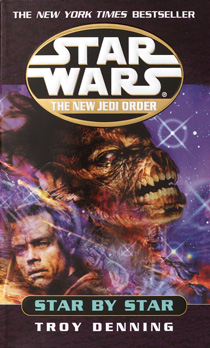“Star by Star” (2001), the ninth book in the “New Jedi Order” series and the first “Star Wars” novel by Troy Denning, is a rough one. I had put off my “NJO” re-read for a long time largely because of my dread of this 606-page behemoth. Whereas reading most of this series is a pleasure, this book is unavoidable homework. Telling myself “Maybe it’s not as bad as I remember,” I embarked on the re-read. But – although I am an apologist for some of Denning’s works, particularly the parts of “Tatooine Ghost” and the “Dark Nest Trilogy” where Luke and Leia learn about their parents – “Star by Star” remains a massive slog, mostly overwritten, but also frustratingly underwritten at times.
Like “Vector Prime,” “Star by Star” is defined by a memorable death that was approved by George Lucas. In this case, Anakin Solo’s death was actually asked for by Lucas as a substitution for Jacen Solo’s death, which was the original plan. Anakin’s demise comes amid a mission by 15 young Jedis (ranging from teenage Tahiri to 20-something Ganner) to kill the voxyn queen on a Yuuzhan Vong worldship orbiting Myrkr.
I’m not a big fan of “journey into darkness” novels to begin with, although if they are better written – like “Shatterpoint” and “The Clone Wars: Wild Space,” which serve up quests through a forest similar to “Star by Star” – I can appreciate them. Denning does one thing fairly well: When Anakin dies, the pain felt by Jacen and Jaina (who are on the scene) and Leia and Han (who know about it through the Force) is palpable. I like the detail of Leia not being able to let go of baby Ben Skywalker, so much so that others fear for Ben’s safety. Certainly, like Chewie’s death, Anakin’s demise will reverberate through upcoming books, as will Jacen’s capture by the Vong at book’s end. That’s why this book is an essential read, even if it’s a near-impossible one.
Five out of the 15 Jedi on the Myrkr mission end up dead, but while Anakin’s death is drawn out and painfully dramatized, you could almost blink and miss some of the other deaths (they are Jedi who are introduced specifically for this novel, with the exception of two of Tesar Sebatyne’s siblings, who were introduced in Denning’s e-book novella “Recovery”).
You’d think a 606-page book would be filled with details, but Denning has an odd way of de-emphasizing some things that should be emphasized. A prime example is when C-3PO and the baby Ben end up separated from Luke and Mara during the chaotic evacuation of Coruscant. Lando ends up recovering Ben, but we don’t see it happen. Lando simply coms Luke and Mara to tell them. (This marks the fourth time the capital planet has changed hands since “Return of the Jedi.” In the “X-wing” books, Coruscant goes from the Empire to the New Republic. And in the opening pages of “Dark Empire,” we see that the Empire has taken it back, but it goes back to the good guys by the end of that series.)

“Star by Star” is relentlessly intense, with the action going right up until the final page. With the exception of characters grieving lost family and friends, or worrying about further losses, this book almost entirely consists of war strategizing and action. An intriguing mystery crops up in the final pages when Luke hands a piece of flimsiplast to Leia, but we don’t get the answer to that mystery in this book – presumably, we must wait till the next one. There’s no decompression built into the narrative; you simply have to set the book aside every now and then.
While Denning fails to tell us important things, he also peppers “Star by Star” with unimportant details. At one point, Mara notes that her X-wing’s astromech droid is called Dancer, and that she named him that for no particular reason. He’s never mentioned again. At another point, we’re given a rundown of the names of a bunch of prominent New Republic military leaders, none of whom are referenced again, in this book or elsewhere. Lando’s generalship is recommissioned, and he is escorted through his new ship by “a winsome petty officer who would have made even Tendra frown with jealousy” (p. 497), but she goes on to play no role in the story.
Denning’s grasp of the rules of the “NJO” seems a little shaky. The Jedi strike team can vaguely sense the voxyn through the Force, but in all previous books, the Yuuzhan Vong and their organic creatures and tech could not be sensed – the lone exception being when Anakin uses the lambent crystal in his lightsaber. And Leia and Han encounter occasional Vong infiltrators, wearing ooglith masquers, as they flee Coruscant, but it’s never clear why those infiltrators are there. Their presence also undermines the characters of Nom Anor, who had been established as THE infiltrator into New Republic space, and Viqi Shesh, the human senator that Warmaster Tsavong Lah had been relying on as an inside source.
Denning is undisciplined and untamed by his editing team, but he shows sparks of talent. The passage where Chief of State Borsk Fey’lya takes a bunch of the enemy with him, using a bomb, rather than be captured, is well-written. It’s a nice send-off to this character who dates back to the “Thrawn Trilogy,” and it makes me reflect on how he was a self-serving politician, but not necessarily an evil one. Fey’lya’s decisions were always based on how they would play with the media and the masses. Because the public in the “Star Wars” EU (at this point in the narrative) is more engaged in politics than the citizens of the modern-day U.S., the Bothan can’t get away with outright evil, but he can play the game so it works in his favor. The idea that he would sacrifice himself for the sake of his legacy – the idea that he went down fighting – is a spot-on piece of characterization.
Another not-so-bad part of “Star by Star” is the introduction of Alema Rar, a sexy Twi’lek Jedi with some darker tendencies who will go on to be a major player in the post-“NJO” books. This book is also a boon for “Young Jedi Knights” fans; although the Solo twins had been main characters in the adult novels for a while, many other stars of those young-adult novels get called up to the big leagues here. The Jacen-Tenel Ka relationship – back-burnered since the “YJK” books – gets subtly resurrected here, a building block for later stories. The author also regularly references the young Jedis’ previous harrowing experiences, notably their capture by the Shadow Academy. Denning knows his “Star Wars” lore, and this strength will come to the fore again when he makes those Skywalker family connections in “Tatooine Ghost” and the “Dark Nest Trilogy.”
Denning will significantly improve as a writer in his future “Star Wars” books, but this debut is unwieldy and ridiculously overlong. It presents a tough hurdle to clear in the middle of the “NJO” saga. But now that I’ve cleared it, I’m looking forward to the back half of the saga.

